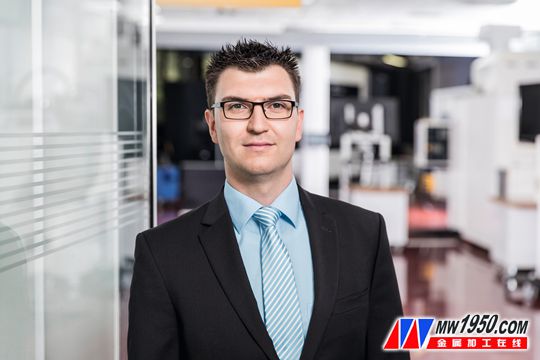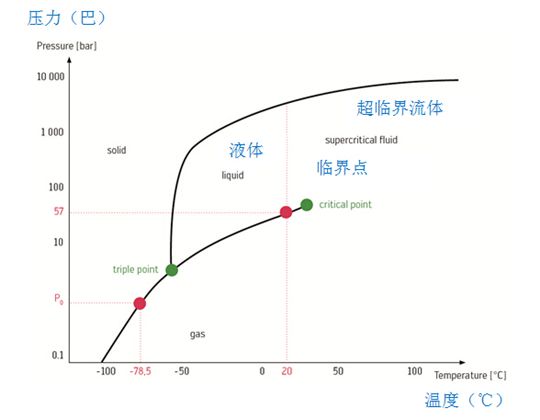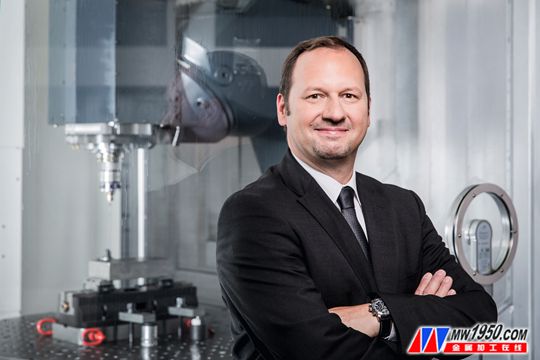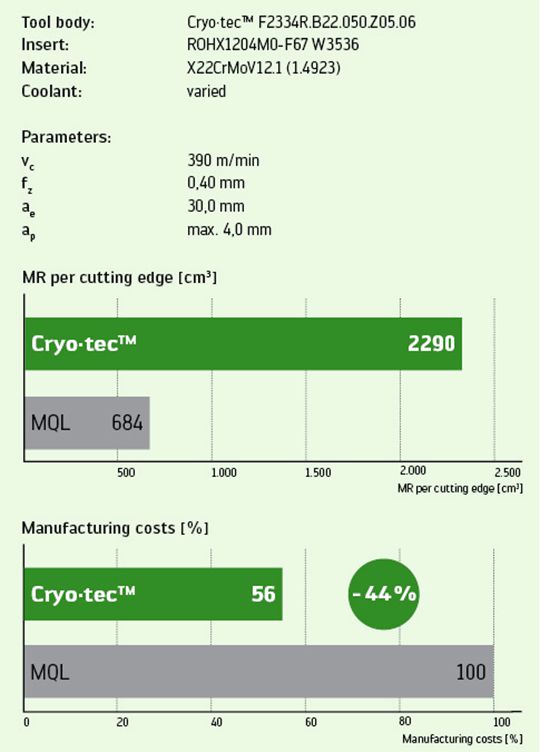The F2334R has two slots for supplying two different types of coolant: one for CO2 and the other for MQL, compressed air or emulsion. Carbon dioxide flows through the tool in liquid form at a pressure of 60 bar and is sprayed directly near the cutting edge. The carbon dioxide then expands here to form dry ice to achieve the desired cooling effect. “ The key development step for Cryo·tecTM is to use a two-slot system to supply internal coolant to the tool instead of an external coolant supply system,†said Thomas Schaarschmidt, head of turbine blade processing at Walter. “Using five-axis machining, External carbon dioxide can never achieve the desired effect, that is, it is impossible to be as close as possible to the high-temperature cutting area. When processing titanium alloy, in addition to pure cooling, lubrication is required. In the method described in this paper, the double-slot cutter is used to separate MQL and carbon dioxide. Starrag is responsible for the development of special mandrels, while Walter is responsible for providing optimized tools. The advantages of the cryogenic cooling concept are as follows: low tool wear and longer service life; optimized cutting parameters, higher production efficiency; better surface quality, boundaries The area has less impact and the part quality is higher; the chips are 100% recyclable and there is no need to prepare for maintenance of lubricants or parts cleaners. high pressure Cooling performance Future cutting technology With the development of food culture, from simple cooking tools, gradually evolved into both use and artistic value of household articles.The classification and function of Kitchen Knives are more and more detailed, from the era of a Kitchen Knife fighting the world, developed into today's special combination of knives.We can provide customers all over the world with the best quality pizza knives,also we can customize different pizza knives according to the living habits of different countries. Pizza Knife,Butter Knife,Pizza Cutting Knife,Kitchen Butter Knives HONG TAO KITCHEN INDUSTRY CO.,LTD , https://www.htkitchenware.com
Walter's F2334R blade with Cryo•tecTM technology 
Thomas Schaarschmidt, Walter Business Development Energy Manager and Head of Blade Processing Technology: Customers have accepted a full range of solutions including tooling and technical expertise 
Carbon dioxide phase curve 
Andreas Elenz, Director of Business Development at Tuebingen Walter, follows a fine tradition: “Energy production has become one of the major industries we have focused on for decades.†
The surface quality of the root part of the blade after roughing, one using dry processing and the other using carbon dioxide plus air cooling 
Coarse machining of austenitic stainless steel turbine blades with Cryo•tecTM technology saves significant cost compared to dry machining
Blade processing itself is a science. In the past, blade manufacturers faced equipment problems; today, they are mainly faced with headaches caused by blade materials. To further optimize efficiency, turbine designers are looking for the best solution for increasing input temperatures. Because special materials are required to meet high temperature requirements, the manufacturing cost of the blades is increased. Traditional ferritic, martensitic and austenitic turbine steels are no longer suitable for high temperature requirements and are replaced by nickel-based superalloys. However, such materials require longer processing times. In this sense, the most important factor is the use of innovative matching tools and machining concepts to control manufacturing costs, such as the concept of effective high-performance cooling processing.
Walter, based in Tübingen, has a long history of developing tools and processing solutions for the energy industry. “For decades, energy production has become one of our key industries,†said Walter Business Development Manager Andreas Elenz. “We are a full-service provider of all key components, including blades of course. This means assurance Roughing cutters for indexable inserts with maximum metal removal rates to solid carbide end mills with minimum transition radii are equipped with all tools (this amount is quite large for the blade machining field).
Cooling concept
Tool cooling is particularly important. It not only has a great impact on the tool itself, but also the high temperature generated during machining. It is related to whether the cemented carbide matrix compressive stress is generated during the machining process of the turbine and its performance is limited. Unlike steel, when machining difficult-to-cut materials, heat is generally not removed by the chips, and heat is infiltrated into the chip edges to soften the cobalt-tungsten carbide.
In early 2013, Walter and Zwickau Saxon University of Applied Sciences Institute of Production Technology (IfP) worked together to conduct basic research on the use of liquid carbon dioxide cryogenic processing, in which the cutting edge has been cooled to -78.5 ° C, Zwickau experiment all An external cooling supply was used and various cooling strategies (MQL, emulsion, carbon dioxide and various combinations thereof) were compared to each other. The comparison results show that the carbon dioxide method has the greatest cooling potential and has obvious advantages. When processing stainless steel turbine blades, the cost savings are as high as 40%. Through this pioneering basic research and working closely with Swiss Starrag Machinery Engineering, Walter pioneered the world's tooling company with cryogenic cooling principles, providing practical solutions for a wide range of applications in the industry. In March 2013, this technology was first successful and was named “Cryo·tecTMâ€. At EMO 2013, Walter and Starrag received the MM Award for the most innovative reason for their solution in milling.
Special milling cutter
For the tool, the partners chose the F2334R round blade copy milling cutter, which is optimized for blade machining. Its main feature is high processing stability and 5-axis machining. This tool covers 70% to 80% of the entire process, so most metal removal occurs at the turbine blade. 5-axis machining optimizes the groove ratio and cutting force ratio at various locations, even during roughing, to the desired final profile.
An important technical advantage of the Cryo·tecTM cooling system is that it maintains the CO2 pressure for as long as possible on both the machine and the tool. Because as long as the pressure drops, ice begins to form and blocks the carbon dioxide supply path. However, in order to achieve a given cooling effect, the carbon dioxide output should not be too large, because the carbon dioxide coolant is more expensive than the emulsion, and the cost is about 0.30 to 0.50 euros per kilogram. “In determining the nozzle diameter, we invested a lot of manpower and time in our research and development work,†Schaarschmidt said. “We are currently working hard to further optimize pressure regulation and supply to be as close as possible to the cutting area. We are still big. Force and lubricant manufacturers work together to develop new MQL oils. So far, they have been used in high temperature applications, so they need to be combined with carbon dioxide cooling. Currently Cryo·tecTM tools only have non-standard tools, because of the corresponding machine tools of Starrag Spindle technology is still immature. However, Walter is looking for ways to develop a tool connection standard.
Experiments using turbine blades made of martensitic stainless steel (multi-axis turning, original part size 475 mm × 80 mm × 80 mm, welding fixture) show that if carbon dioxide is used for cooling, the temperature at the cutting edge can be lowered by 100 ° C. Tool edge life is extended by 30% compared to dry machining, while cutting parameters remain consistent. At the same time, production costs are saved by 15%. When machining austenitic stainless steels, tool life is greatly extended compared to MQL, and production costs are saved by up to 30%. In general, low temperature processing has great potential for high temperature alloys (HRSA) and stainless steel. It is now necessary to further validate this technology using materials and applications from the ISO S and ISO M groups. In the future, R&D will focus on unresolved issues in parts processing and equipment technology, extraction and disposal in the automotive industry.
Future machine tools may be designed to have both cooling and non-cooling functions (whether or not coolant is used). The only difference is the choice of cutting tool material: one for cooling and one for dry machining. There are additional topics for future R&D. During milling, the used tool teeth are heated and then cooled by engagement and disengagement. This effect can only be fully achieved with low temperature carbon dioxide cooling. Due to the high temperature alternating effect, the cemented carbide substrate and coating expand at different rates, causing the coating to crack, ultimately rendering the cutting tool material ineffective. All of the cutting tool materials developed in the past few years have been used for high-temperature operations in dry machining, but today's cutting tool materials need to be specially designed for low-temperature carbon dioxide cooling to withstand large temperature changes. Therefore, in the future research and development work of Walter, Thomas Schaarschmidt needs to study two major topics: “Our main task in the future is to standardize tool concepts and professional cutting tool materials, because we plan to increase the proportion of difficult-to-cut materials for turbines by 2020. Up to 40%, so the market growth potential in this area is huge, and it is necessary to increase research and development efforts.